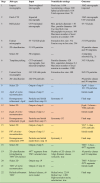Multi-species cryoEM calibration and workflow verification standard
- PMID: 39494502
- PMCID: PMC11533365
- DOI: 10.1107/S2053230X24010318
Multi-species cryoEM calibration and workflow verification standard
Abstract
Cryogenic electron microscopy (cryoEM) is a rapidly growing structural biology modality that has been successful in revealing molecular details of biological systems. However, unlike established biophysical and analytical techniques with calibration standards, cryoEM has lacked comprehensive biological test samples. Here, a cryoEM calibration sample consisting of a mixture of compatible macromolecules is introduced that can not only be used for resolution optimization, but also provides multiple reference points for evaluating instrument performance, data quality and image-processing workflows in a single experiment. This combined test specimen provides researchers with a reference point for validating their cryoEM pipeline, benchmarking their methodologies and testing new algorithms.
Keywords: 3D reconstruction and image processing; benchmarking; calibration; cryo-electron microscopy; education; resolution; single-particle analysis; single-particle cryoEM; structure determination; training; workflow standard.
open access.
Conflict of interest statement
The authors declare that the research was conducted in the absence of any commercial or financial relationships that could be construed as a potential conflict of interest.
Figures




Update of
-
Multi-species cryoEM calibration and workflow verification standard.bioRxiv [Preprint]. 2024 Aug 5:2024.08.05.606612. doi: 10.1101/2024.08.05.606612. bioRxiv. 2024. Update in: Acta Crystallogr F Struct Biol Commun. 2024 Nov 1;80(Pt 11):320-327. doi: 10.1107/S2053230X24010318. PMID: 39149318 Free PMC article. Updated. Preprint.
Similar articles
-
Multi-species cryoEM calibration and workflow verification standard.bioRxiv [Preprint]. 2024 Aug 5:2024.08.05.606612. doi: 10.1101/2024.08.05.606612. bioRxiv. 2024. Update in: Acta Crystallogr F Struct Biol Commun. 2024 Nov 1;80(Pt 11):320-327. doi: 10.1107/S2053230X24010318. PMID: 39149318 Free PMC article. Updated. Preprint.
-
Do's and don'ts of cryo-electron microscopy: a primer on sample preparation and high quality data collection for macromolecular 3D reconstruction.J Vis Exp. 2015 Jan 9;(95):52311. doi: 10.3791/52311. J Vis Exp. 2015. PMID: 25651412 Free PMC article.
-
Principal component analysis is limited to low-resolution analysis in cryoEM.Acta Crystallogr D Struct Biol. 2021 Jun 1;77(Pt 6):835-839. doi: 10.1107/S2059798321002291. Epub 2021 May 19. Acta Crystallogr D Struct Biol. 2021. PMID: 34076596 Free PMC article.
-
Emerging Themes in CryoEM─Single Particle Analysis Image Processing.Chem Rev. 2022 Sep 14;122(17):13915-13951. doi: 10.1021/acs.chemrev.1c00850. Epub 2022 Jul 4. Chem Rev. 2022. PMID: 35785962 Free PMC article. Review.
-
Advances in cryo-electron microscopy (cryoEM) for structure-based drug discovery.Expert Opin Drug Discov. 2025 Feb;20(2):163-176. doi: 10.1080/17460441.2025.2450636. Epub 2025 Jan 16. Expert Opin Drug Discov. 2025. PMID: 39789967 Review.
References
-
- Alink, L. M., Eng, E. T., Gheorghita, R., Rice, W., Cheng, A., Carragher, B. & Potter, C. S. (2021). bioRxiv, 2021.11.04.467268.
-
- Danev, R., Yanagisawa, H. & Kikkawa, M. (2021). Microscopy, 70, 487–497. - PubMed
MeSH terms
Substances
Grants and funding
LinkOut - more resources
Full Text Sources

